Like most wine lovers, I keep a fair amount of wine at home. While I rent space at an offsite wine storage facility (if you’re interested, Eastside Wine Storage which is excellent) for my high-end wines, I still want to make sure that the wines I keep at home are stored reasonably well.
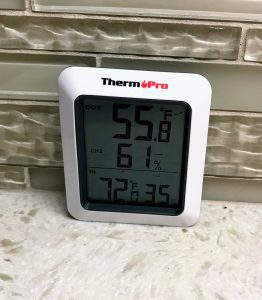
I noticed that the temperature in my garage here in the Seattle area stayed reasonably consistent even in summer and I began using that. But with the heat wave of this past summer, I wanted to track the conditions in my little “home cellar” more closely, so I purchased from Amazon a Thermo Pro TP60 Digital Thermometer/Humidity Monitor for $18.
Background On Wine Storage
Jancis Robinson’s Oxford Companion To Wine notes that the four most important considerations for wine storage are temperature, humidity, light (avoiding both halogen and UV) and security. I will also add that you generally want to prevent vibrations as well which is why storing wine above the refrigerator and in many poorly made wine fridges is not ideal.
While for short-term storage, temperatures that don’t stray too much towards 77°F (25°C) are acceptable with long-term storage (and high-quality wine) you want temperatures ideally in the 50-59°F (10-15°C) range.
With humidity, you don’t want a storage area too damp where mold could develop, but you also don’t want it too dry where the corks dry out and promote oxidation. The ideal relative humidity for wine storage is between 55-75% with Robinson encouraging folks to aim closer to the 75% range. A best practice, especially if you don’t have ideal humidity is to store your wines on their side where the wine is in contact with the cork to keep it moist.
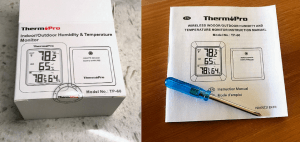
The tiny blue screwdriver is adorable.
Product Specs
The Thermo Pro TP60 came with the outdoor transmitter and indoor receiver and 4 AAA batteries. It also came with a little screwdriver to access the battery slot on the transmitter. Both devices took 2 AAA a piece.
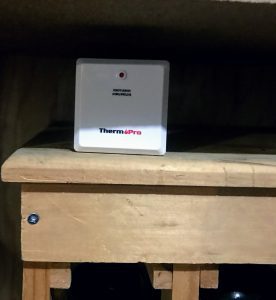
The outdoor transmitter in the garage
The outdoor transmitter is waterproof and can withstand temperatures ranging from -58°F to 158°F and humidity between 10% to 99%. These figures are all well within the scope of my garage/wine cellar. It has a built-in wall mount, but I found it sits perfectly fine on one of my wine racks.
The indoor receiver has similar specs as the outdoor transmitter. On the back, you can toggle between Celsius and Fahrenheit. The unit will record the maximum and minimum temperature and humidity readings which you can access by pressing the max/min button on the back. You can also clear these readings by pressing and holding that button.
The system can accommodate up to 3 different transmitters. The receiver will toggle between the three up to a range of 200 feet. I’m keeping the receiver on my dining room wine bar which is less than 20 feet from the transmitter in the garage.
Set Up
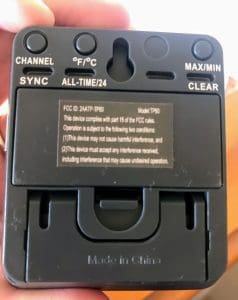
The back of the indoor receiver.
After putting the batteries in, you need to keep the two units close together so they can sync up. This can take at least 3 minutes. We initially had issues getting the units to sync. I had to repeatedly hold the Channel/Sync button on the back of the indoor receiver before it finally worked.
After it is synchronized, you can move the outdoor transmitter to its desired location. Here it will send data to the indoor receiver. On the indoor receiver, you can also get readings of the current indoor temperature and humidity as well.
Even after we got the device synchronized, it acted a little wonky. We frequently got bizarre readings like the “outdoor” temp being 73°F. This being winter in Seattle, I knew that wasn’t right and suspected that it was giving us the indoor temp. After about 10 minutes or so it seemed to have self-corrected. It’s been working perfectly fine now for the last several weeks.
Verdict
My favorite feature is the recording of max & min readings as well as the little arrows that appear to the side of the temperature and humidity that shows how those measurements are trending. If I’m away on business, I can clear the history before my trip. Then when I get back, I can review to see if any heat spikes occurred while I was gone.
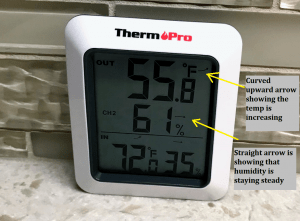
I always knew that Seattle was fairly humid. However, I was surprised at how relatively low the humidity in my garage was. Most of the readings were regularly 60-65%. Still within the “acceptable” range for wine storage but could be a problem in drier summers. While I regularly keep my good bottles on their side, these readings are incentive to stay on top of that.
So far I feel like the $18 for the Thermo Pro TP60 has been money well spent for the peace of mind of knowing what kind of conditions my wines were kept in–especially when I’m storing bottles here that are regularly more than $18 each. Few things are more frustrating in life than opening up a faulted bottle. But having that bottle be faulted because of something you did (or didn’t do) certainly tops that.
